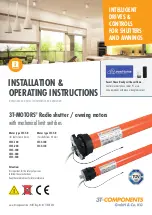
Catalogue HY29-0037-M1/UK
Overall Hydraulic Motors, Fixed
M5AS - M5ASF Denison Vane Motors
32
Parker Hannifin SAS
VPDE, Denison Vane Motors
Vierzon - France
1 . No rotation
2 . Stalls easily
3 . Not enough speed
4 . Erratic speed
a-1) Check the circuit and the hydraulic schematic. Is the piping O.K.?
a-2) Check the setting of the main pressure relief valve.
a-3) Check if the pump is delivering flow.
a-4) Check if the directional valve is allowing the flow to go to the motor.
Check if the directional valve is energized. If it is, check if the spool is in its
correct position and not sticking in a position that would deviate the flow
somewhere else.
a-5) Check if a check valve would not have been wrongly mounted.
b-1) Check if the pressure settings are correct.
b-2) Check if the load is not superior to the torque capabilities of the motor.
c-1) Check if the pump is working correctly.
d-1) Check the nature of the connectors. If, for example, the “self sealing
quick couplings” type connectors are well locked into each other.
a-1) Check the relief valve setting value and compare it to the theoretical
pressure required to deliver the convenient torque.
b-1) Check the minimum flow required by the motor.
b-2) Check the flow of the pump or the valve feeding the motor.
c-1) Check that the valve is OK (properly installed, ball seat pollution).
a-1) Check the theoretical displacement of the motor versus the theoretical
flow of the pump.
a-2) Check that the flow of the pump is really arriving at the motor.
a-3) Check that the working pressure & speed are in accordance with the
catalogue values of the motor.
a-4) Check the fluid temperature. Check then that the low viscosity of the
fluid is not having a big effect on the internal leakage of the motor.
a-5) Check the air bleed-off.
a-1) Check if the limit of the allowable torque is not reached once a while.
a-2) Check if the driven device does not transmit some inconstant load.
a-3) Check if the flow coming from the pump is constant.
a) Is the flow coming
at the motor?
b) Is the torque requi-
red higher than the
system settings?
c) Is the pump OK?
d) How is the motor
piped?
a) Is the load close to
the limits of the sys-
tem?
b) Is the flow going to
the motor sufficient?
c) Is the anti-cavitation
valve closed?
a) Is the speed lower
than desired?
a) Is the motor loosing
speed erratically?
7 . TroubleSHooTing guiDe :
Vane troubleshooting guide





































